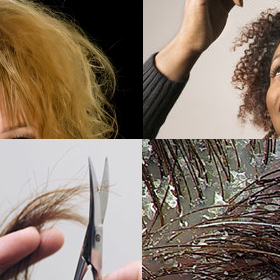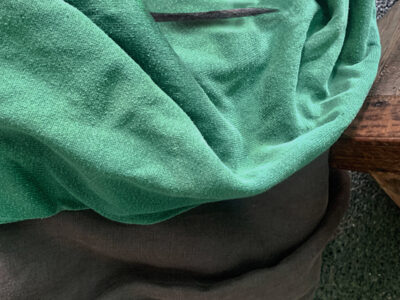“What do I do for dry hair or dry scalp?”
First, we need to understand that the two conditions are different.
Dry Scalp
Dry scalp — itching, flaking, or both — is frequently an irritation. It could be a chronic contact dermatitis or a reaction to allergens in hair products. Some common culprits include allergen surfactants like “amido-amines” (cocamidopropyl betaine, cocamide-dea), or other common allergens like dyes, fragrances, or preservatives.
Dry scalp can also be caused by the fungus pityrosporum going on overdrive. It might sound a little gross but a) we need to get more comfortable with the microorganisms that keep us healthy instead of bombing them all to oblivion — check out this awesome New Yorker article on the Human Microbiome Project; b) we all have pityrosporum within our hair follicles (it’s meant to be there); and c) our skins and hair have a nature-perfected balance between diverse microorganisms. Sometimes, such as after using too many “antiseptic” or antibacterial hair products or taking oral antibiotics, this balance gets thrown off. In the scalp, pityrosporum and other healthy microbes usually keep each other in check. With the overuse of “antimicrobial” hair products or after antibiotics (why scientists are moving way from the “napalm” approach to microbes), too much of the bacteria that normally would control pityrosporum get killed off and pityrosporum has too much of a free reign. Then it goes on a bender.

Before you start freaking out about an uncontrolled multitude of mutinous microbes, relax. It’s usually surprisingly easy to improve dry scalp.
- Choose allergen-free shampoos, conditioners and hair styling products. Essence Clark Wash “Big Softie” Hair & Body Wash and Essence Skin-Saving Conditioner are good options.
- Ease the dryness by gently massaging an oil or lotion with non-irritating anti-fungals such as monolaurin into the scalp. Try Grandma Minnie’s Oil’s Well. It contains pure virgin coconut oil, which is excellent for hair (it’s an ingredient in so many intensive hair conditioners for good reason) as well as monolaurin, an effective, coconut-derived, non-allergenic, antifungal.
- Try to steer clear of hair styling products for a while to prevent exposure to allergens as much as possible.
If your dry scalp remains even after switching to hypoallergenic options, you could have seborrheic dermatitis and/or psoriasis. These two conditions are usually very manageable but do need a proper diagnosis and some additional care. While the allergen avoidance described above would still be recommended, you may need some lifestyle changes (stress management, improved diet and exercise), and some specific medicines.
If you don’t see an improvement in your dry scalp with the steps above, consult a dermatologist — ideally one who specializes in contact dermatoses as well as seborrheic dermatitis and psoriasis — and ask your doctor about getting a patch test. Often, simply knowing exactly what you need to avoid can result in dramatic changes.
Dry Hair
This is physical damage of the hair strand itself and is normally due to an injury to the hair shaft. Such injuries can happen in several ways. Harsh ingredients found in some anti-dandruff shampoos can cause injury to the hair shaft, as can frequent color stripping and/or dyeing; regular hair curling, heating or straightening treatments; frequent blow-drying or other heat styling; styling, particularly with strong-hold products; and pulling of the hair strands (using hair elastics and headbands).
What to do?
- First, be nice. At this point, it may not enough to use a very gentle shampoo (although that helps, too — see Essence Clark Wash “Big Softie” Hair & Body Wash above). The hair needs real babying to reduce the stress on stretched hair shafts or broken cuticles.
- Before washing your hair, try giving it a protective barrier. Coat the hair shafts by gently massaging The Big, Brave Boo-Boo Balm through your hair. Use a wide-toothed comb to improve distribution. This can help keep harsh ingredients or detergents from getting into breaks in the hair shaft.
- Avoid ingredients that can potentially break down hair such as dyes, fragrance, and preservatives.
- Use a very rich but non-irritating conditioner, and virgin coconut oil for repair.
To find a dermatologist in your area, visit AAD.org or your country’s official dermatological society.
To find a physician in your area who does patch tests, visit contactderm.org.
For a customized regimen or consultation, call us at (212) 226 7309.
“Dew” More:
To shop our selection of validated hypoallergenic products, visit vmvhypoallergenics.com. Need help? Leave a comment below, contact us by email, or drop us a private message on Facebook.
If you have a history of sensitive skin, don’t guess: random trial and error can cause more damage. Ask your dermatologist about a patch test.
Learn more:
On the prevalence of skin allergies, see Skin Allergies Are More Common Than Ever and One In Four Is Allergic to Common Skin Care And Cosmetic Ingredients.
To learn more about the VH-Rating System and hypoallergenicity, click here.


[…] more about how hypoallergenic helps dry hair and dry scalp. And try this for a great (hypoallergenic) hair […]